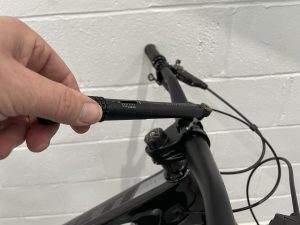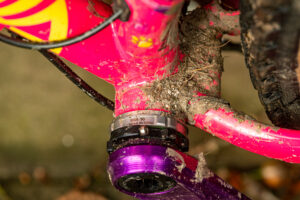The new Santa Cruz Tallboy blends big bike geometry with small bike travel: so is it a trail bike, an XC bike, or something else entirely?
Santa Cruz Tallboy: first ride review
The new Santa Cruz Tallboy blends big bike geometry with small bike travel: so is it a trail bike, an XC bike, or something else entirely?
>>> Best mountain bike 2019: all you need to know

Like a self-confident Jack Russell, the Tallboy has no concept of its own size and stature
Santa Cruz Tallboy need to know
- Modest travel meets aggressive geometry
- One of three new 29ers from Santa Cruz this year
- 120mm rear travel paired with 130mm suspension fork
- High end CC carbon frame offered alongside less costly C and alloy frame options
- Flip chips to tune suspension feel and geometry, including chainstay length
- Range starts at £2,899
You wait ages for a new Santa Cruz 29er and three come all at once. Yes, 2019 has been all about big wheels for the brand, with the Santa Cruz Megatower, Santa Cruz Hightower and now this, the Tallboy, all launched in the space of six months. Busy times at Santa Cruz towers, then, although, so similar are the new bikes you could be forgiven for thinking the whole thing was just a cut and paste job.

Can you spot the difference? From L-R, Tallboy, Hightower and Megatower
Try as you might, there’s no getting away from the fact that they look almost indistinguishable, and not simply because they all use Santa Cruz’s latest lower link-driven shock arrangement. VPP’s in a pod, if you will. The geometry is also similar, no wait, virtually identical, which ensures their silhouettes are even more closely aligned. That leaves travel as the principle differentiator, with the Megatower packing 160/160mm, the Hightower 150/140mm and the Tallboy 130/120mm. Which, if my own head scratching is any kind of barometer, probably means there are quite a few prospective Santa Cruz owners out there thoroughly confused as to where to invest their cash.

Loads of standover clearance and a short seat tube let you decide whether you want to go long or short on reach by sizing up or down
While the shock location brings the greatest step up in performance over the previous Tallboy, if you’ve never chucked a leg over one before, it’s the low-slung frames that you’ll notice first. Like the Megatower and Hightower, it gets an ultra low standover height combined with a shorter seat tube and longer dropper post that gives more flexibility when choosing your frame size. In fact, I’ve now re-evaluated my own preference, moving up to an XL from a Large, despite being of only average height. Not only does it give me the perfect saddle height with a 170mm drop Reverb, but I get a better fit with the 490mm reach. The only modification I made was to knock the stem length back 10mm from stock to claw back some of that additional reach.

Flip chip doesn’t make a lot of difference to the geometry, but does change the suspension feel. Shock protected by a neat mudguard, and there’s a grease port for servicing the bearings
The Tallboy lets you play with much more than just your cockpit set-up. There’s the now familiar flip chip at the lower link – that raises and lowers the BB height a smidge, as well as tweaking the head angle – but serves principally as a way of changing the interaction between the VPP link and the shock. In the low position it has a little less mid-stroke support but more ramp up, and the high setting reverses this effect.

Dropout chips, along with a different brake adaptor, let you adjust the chainstay length by 10mm
Then there are the dropout chips first seen on the Megatower – a welcome, if curious, move in my opinion. Why so? Well, if they provide sufficient benefit on the Megatower and Tallboy to justify their extra weight and expense, then why not the Hightower? Surely that’s the bike with the widest appeal? Either way, if you’re a prospective Tallboy owner, you’re in luck, as you’ll be able to experiment with your weight balance, as well as alter the handling of the bike as a result. Lanky riders on the XL and XXL can try out longer chainstays to help weight the front end. Equally, the longer chainstay option could be the better set-up for steeper climbs and steeper descents, while the shorter chainstays should promote more rapid direction changes and a livelier front end. It won’t be a feature you’ll use every ride, in fact you may well set and forget, but it’s still worth having as it really helps those at either end of the bell curve find a good balance, particularly when you have a size range that’s as wide as Santa Cruz’s.

Cable routing for UK riders was always an afterthought on Santa Cruz frames, but the neat head tube ports make that a thing of the past.
How it rides
Let’s get straight to the point. The new Tallboy makes you realise that most of us are overbiked for the riding that we do, and at the same time, it gives you an insight into the reason why. By that, I mean that it’s a bike that reaches the limits of its suspension travel long before its geometry gets out of depth. And so it has the potential to join an exclusive collection of models that have made us pause for thought and reconsider what is actually required from a trail bike in recent years. Models like the Specialized Camber Evo, Evil The Following, Kona Process 111 and perhaps even the original Santa Cruz Blur 4X.

The fast, flick-flack corners of Angry Sheep at Innerleithen felt amazing on board the Tallboy
Heady praise, but it’s justified. There is no question this is a capable bike. During its three days in my custody, it accompanied me on a tour of the Tweed Valley’s latest and greatest hits, in conditions that are typical for the region: damp, dark, greasy and predictably unpredictable. From machine built flow trail to old-school downhill track and bum-surfing hand-cut descents, it didn’t put a foot wrong. Rarely did I want for more travel, and save for a few occasions – following world-class locals Mark Scott, Chris Ball and Andy Barlow aboard big calibre Megatowers – I never felt the need to back off the throttle.

Negotiating Golfie’s tight trees was hampered by the 800mm bars fitted to our test bike, but you can always cut them down
The XL’s additional length helped keep the Tallboy travelling forwards, even when it was pointing sideways, yet it also let me rail tight corners, popping from one apex to the other, and balance momentum with traction on technical climbs. Where the longer front end did tell was initiating manuals; I had to exaggerate my movements and effort to get the front wheel up compared to a smaller frame size.

If the trail was fast but not too rough, the Tallboy was king of the hill
Like most Santa Cruz bikes, the VPP system worked effectively in the background without ever raising its voice to be heard – performing like a backing vocalist rather than a lead singer. There’s good support and enough progression for pumping the bike, but it never felt outstanding at absorbing bumps and generating grip. On the flip side, it climbs and sprints with typical VPP efficiency, such that the blue compression lever on the Fox Float Performance Elite shock can be completely ignored. As stable as it is under power though, do not make the mistake of thinking the Tallboy has the instant snap and urgency of an XC race bike; this is still very much a trail tool in the way it responds to your pedal inputs.

Although it doesn’t have the poppiest suspension feel, the Tallboy is a heap of fun on jump trails
As I alluded to earlier, the geometry lets you take liberties that the suspension cannot always back up. This is something you have to keep at the back of your mind at all times when riding the Tallboy. To avoid dive-bombing into the shallow end, you have to moderate your speed and temper your confidence going into gaps, rock gardens or steep chutes in case, when you get there, the suspension suddenly runs out of travel. More so at the helm, where the RockShox Pike Select+ fork never quite felt fully comfortable mopping up my overexuberances. Considering what Santa Cruz is charging for this high end X01 CC model, I’d expect to see the top end Pike Ultimate, with its better Charger 2.1 damper, fitted as standard instead.
Verdict
For some riders this 'just enough', 'less is more' approach will be appealing, in the same way that riding a hardtail can be liberating; less suspension travel equals more rider involvement and a more direct connection with the ground beneath your wheels. There's nowhere to hide on a short travel bike, and that forces you to up your game. If you fall into that category, then you'll love the Tallboy. But you have to be resolved to either suck up the shortfalls if you take it somewhere really rough, or you take care to keep the terrain within its limits. Equally, if you prefer the comfort blanket of longer travel suspension, the Hightower and Megatower will do a much better job of massaging your ego and plastering over any cracks in your technique. That sounds like tough love, and it is, but hopefully, in the spirit of Cilla Black, it'll provide a better matchmaking service in the long run. Myself? Well, I still can't make my mind up, despite riding all three models extensively.
















